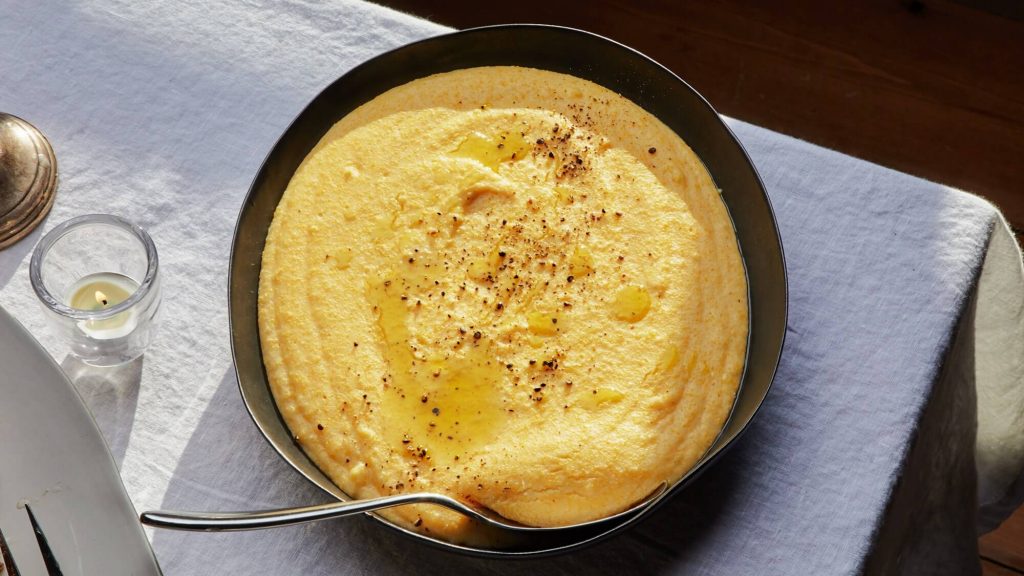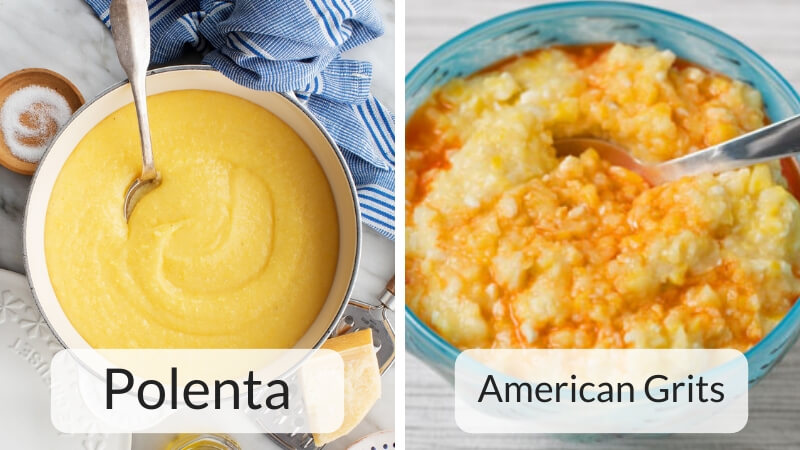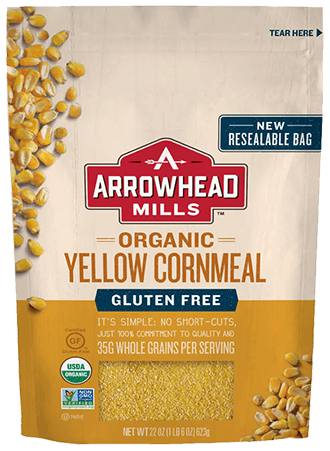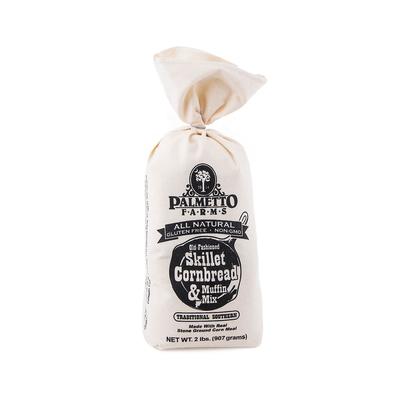- Polenta is an amazing gluten-free substitute for pasta.
- Since it’s not an ingredient but a dish in itself, it can be either consumed alone or combined with almost anything: vegetables, eggs, meat, cheese, sauces, etc.
- Cross-contamination may happen if polenta is processed in a facility that also processes gluten-containing grains. So make sure to opt for polenta brands that are clearly labeled as gluten-free.
- Even though most celiac and gluten-sensitive people tolerate corn, the zein protein in corn may trigger an autoimmune response in some rare cases.
Is polenta gluten free? Yes, it is. You can move on to the next article now. Honestly, It’s made of corn, so we all know corn is gluten free. However, if you want to learn more about polenta and see some popular brands please read on.
A versatile and delicious dish, polenta makes a great alternative to pasta. Since it’s not an ingredient but a dish in itself, it can be either consumed alone or combined with almost anything: vegetables, eggs, meat, cheese, sauces, etc.
Since it is made from medium-ground or coarse cornmeal, polenta is gluten free and can be safely consumed by celiac and gluten-intolerant people.
However, the risk of cross-contamination during processing is rather high. So it is advisable to look for varieties that are labeled as gluten free.
Is Polenta Gluten Free – What is polenta

Polenta originated in Northern Italy as a dish for the poor people. However, nowadays, polenta is present on the menus of some of the most elegant restaurants around the globe.
It is usually made of medium-ground or coarse cornmeal. Usually, the cornmeal is made of yellow maize. However, white maize is not uncommon either.
There are other varieties made of ground rice or buckwheat. But yellow cornmeal polenta is by far the most consumed one.
Coarse ground polenta will have a thick mixture, making it ideal for frying and even baking. In exchange, medium ground polenta has a creamy texture that combines perfectly with meats and sauces.
Polenta is easy to make and rich in nutrients such as Vitamin A, protein, and fiber.
Related: Is food coloring gluten free | Is Aunt Jemima syrup gluten free
Normally, cornmeal is mixed into boiling water (in a 1:4 proportion) and requires constant stirring for approx. 45 minutes.
But, if you are in a hurry, you can also opt for pre-cooked, instant, or quick-cooking polenta varieties. The classic recipe only requires polenta, water, salt, and butter.
So, is Polenta gluten free or not?
YES, polenta is in fact gluten free as it’s made mainly from corn. However, as with all foods that are store bought, you need to carefully read the label on the box to make sure it’s labeled as Gluten Free if you have a Gluten allergy or Celiac disease.
Many products that may be naturally gluten free may have been cross contaminated by either been manufactured in a factory that also handles gluten rich products or by packaging and other forms of handling that may not be gluten free clean.
Is Polenta Dairy Free?
Cornmeal by itself is dairy free, so you can in fact make polenta that will be dairy free. Depending on the recipe you will make, it may be dairy free or not. For example if you add milk rich products to your cornmeal, it will NOT be dairy free.
Same goes for butter, or any type of cheese. So knowing what goes into your meal is very important.
You can however add water instead of milk, or even use chicken stock and this way you make sure the polenta is dairy free.
Making it at home is the best way to make sure you know what’s inside, when eating out you need to ask a lot of question and double check with your server or chef about what was put into the meal.
Is Polenta vegan?
Polenta can easily be made as a vegan meal. Corn by itself is vegan, and if you don’t use any milk, butter or other animal based foods, you can be sure the polenta you just made is vegan.
Using products like vegan based butter, or dairy free milk can insure that you have almost the same taste polenta like the dairy based meal.
Polenta vs. American Grits

Polenta is similar to the famous American grits in both preparation and taste. However, there is a key difference: polenta comes from flint corn, an Italian variety of corn, while grits are made of dent corn.
Since flint corn has less starch than dent corn, polenta is less creamy than grits.
What is Gluten?
Gluten is a type of protein that can be found in what grains and other grains and basically it what makes the products you eat from wheat stick. It’s like the glue of bakery.
Gluten can be found in wheat, but you be surprised by the amount of processed food out there that also contain gluten. People with Celiac disease or just people who avoid gluten need to read carefully the ingredient list before consuming food.
Known brands for gluten free polenta
Bob’s Red Mill Gluten Free Corn Grits/Polenta

According to its manufacturers, Bob’s Red Mill Gluten Free Corn Grits/Polenta is produced in a gluten free facility.
You can find a list of all their gluten-free products here.
Sam Mills

A company based in Romania, Sam Mills produces polenta and grits that can be considered gluten-free (to less than 20 parts per million).
Their products are also 100% GMO-free. You can check the product list here.
Arrowhead Mills

According to the information available on their website, rigorous tests are run periodically to ensure that no product labeled as gluten free contains any gluten.
The production facilities are closely monitored to avoid cross-contamination.
Main characteristics:
• Wheat Free
• Made With No Genetically Engineered Ingredients
• Made with Non-Gluten Ingredients
• Dairy Free
• Vegetarian
• Sodium Free
• Whole Grain Flour
Palmetto Farms

This manufacturer produces three varieties of corn grits: stone-ground mixed, stone-ground yellow, and stone-ground white.
Palmetto Farms tested its traditional grits for gluten and the results showed below 5 parts per million, which is considerably below the established standard of 20 parts per million.
You can check out all their products here.
Beware: Their cheese mixed grits are not included under the gluten-free certification.
What to look out for
Since polenta is made of corn, which is a gluten free grain, it can be safely consumed by celiac and gluten-sensitive persons.
However, corn contains a protein called zein that, in rare cases, may trigger an autoimmune reaction in people who suffer from celiac disease.
While it is true that most celiac tolerate corn well, some celiac and gluten-sensitive people may react to corn. If your symptoms do not improve after eliminating gluten from your diet, you can try to eliminate corn-based products as well to see if your symptoms ease.
As we have already mentioned, corn is a naturally gluten free grain. However, cross-contamination may happen if polenta is processed in a facility that also processes gluten-containing grains.
So make sure to opt for polenta varieties that are clearly labeled as gluten free.
Sometimes, in order to enhance the final taste and appearance of the dish, gluten-containing ingredients may be added. Especially in restaurants.
So, if you are eating out, don’t hesitate to ask as many questions as necessary to make sure your polenta is really gluten-free.
To sum up
Polenta is an amazing gluten free substitute for pasta. Made from medium-ground or coarse cornmeal, polenta combines deliciously with almost anything: meat, eggs, cheese, vegetables, etc.
Even though most celiac and gluten-sensitive people tolerate corn, the zein protein in corn may trigger an autoimmune response in some rare cases.
Since cross-contamination can occur during processing, it is advisable to opt for brands that have been labeled as gluten free.